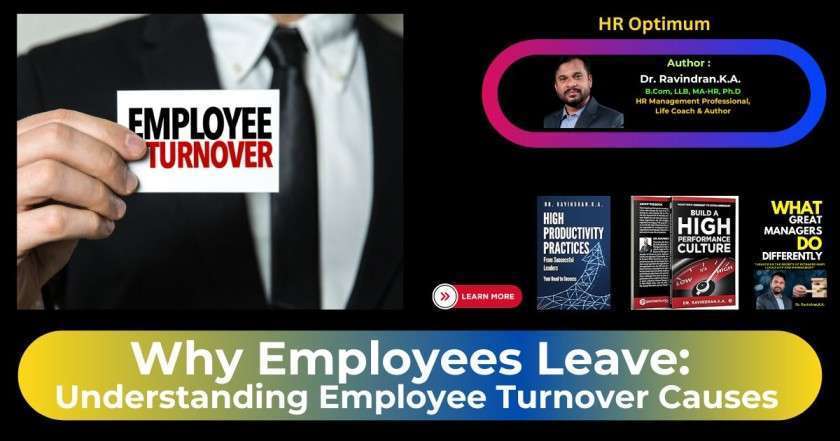Understanding Employee Turnover Rates: What’s a Good Employee Turnover Rate
Are you a business leader in India wondering about a healthy employee turnover rate for your company? Tracking your turnover rate is key to understanding your workforce’s health and your talent management success. But what’s considered a “good” rate, and how can it help improve your workplace?
Thank you for reading this post, don't forget to subscribe!Key Takeaways
- Understanding the difference between voluntary and involuntary turnover can help you identify the root causes of employee departures.
- Accurately calculating your turnover rate requires careful data collection and analysis of employee trends.
- Benchmarking your turnover rate against industry standards can reveal areas for improvement in your hiring practices and employee engagement initiatives.
- High turnover rates can negatively impact your organization’s productivity, morale, and bottom line, while low turnover suggests a satisfied and dedicated workforce.
- Monitoring turnover patterns across departments and job levels can uncover specific pain points that require targeted retention strategies.
What Is Employee Turnover?
Employee turnover means how many employees leave a company in a certain time. Companies look at turnover rates yearly or every three months to see how stable their team is. Looking at turnover helps understand if a company’s hiring, pay, and career growth plans work well.
Voluntary vs. Involuntary Turnover
When workers leave on their own, it’s called voluntary turnover. This could be for new jobs or moving. On the other hand, involuntary turnover happens when a company fires someone, they retire, or there are layoffs.
The average turnover rate is about 10.6% across different fields. But, some areas like professional services (13.4%), tech (12.9%), and hotels (11.8%) see more people leaving. A study by Mercer found that most employee departures in the U.S. are by choice, often because of low pay (74%) or few chances for career growth.
Knowing why people leave helps companies keep good workers, improve pay and benefits, and create a better work environment. This supports career growth and keeps people happy.
“Replacing an employee can cost between one-half and two times the worker’s salary, according to Gallup estimates.”
Understanding employee turnover helps companies keep their best workers, plan their workforce better, and succeed in the long run.
Calculating Employee Turnover Rate
It’s key for any business to keep track of employee turnover. This helps keep the workforce productive and engaged. To figure out the employee turnover rate, just follow three steps:
Step 1: Collect Necessary Information
First, you need to gather some info. This includes:
- The number of employees at the beginning of the time period
- The number of employees at the end of the time period
- The number of employees who left during that period
Step 2: Calculate the Average Number of Employees
Next, add the start and end employee counts and divide by 2. This gives you the average number of employees during that time.
Step 3: Calculate the Turnover Rate Percentage
Finally, to find the turnover rate, divide the number of employees who left by the average number of employees. Then, multiply by 100. This gives you the employee turnover rate for the period.
The formula to calculate the employee turnover rate is:
Turnover Rate = (Number of Employees Leaving / Average Number of Employees) x 100
For example, if a company had 147 employees at the start of January and 148 at the end, with 3 leaving, the average was 147.5. The turnover rate would be 2.04% ((3 / 147.5) x 100).
It’s a good idea to check the employee turnover rate often. Consider doing it monthly or quarterly, not just yearly. This helps spot trends early and address issues like onboarding, workforce analytics, or professional development.

Analyzing Your Employee Turnover Rate
Understanding your employee turnover rate is key. But, it’s even more valuable to analyze it deeply. This way, you can find hidden insights. These insights help you fix issues in your organizational culture and talent management practices.
Start by asking some important questions. Who leaves your company? Why do they leave? Is there a pattern in their departure? These questions can help you spot attrition metrics and problem areas not seen in the overall turnover rate.
- Look at the employees who left. Are there differences in turnover rates by age, gender, or job? This could show issues with equity, career growth, or management.
- Find out why employees leave. Use exit interviews or surveys for this. Common reasons include low pay, poor work-life balance, or bad leadership.
- See if there are patterns in your turnover data over time. Are there seasonal changes or spikes after certain events? Knowing these patterns can help you stop turnover before it happens.
- Check which departments or jobs have the most turnover. This could mean there are specific challenges in those areas that need special attention.
By deeply analyzing your employee turnover data, you can find the main reasons for leaving. Then, you can make plans to fix these issues. This might mean looking at pay, offering flexible work, or improving onboarding and leadership programs. Keeping an eye on your turnover rates and other metrics will show if your efforts to keep employees are working.
“Losing a worker can cost a company up to 1.5-2x a worker’s salary. Credit Suisse saved $70 million per year in turnover costs by using a turnover model to identify turnover risk factors.”
By looking at your employee turnover rate from all angles, you can find important insights. These insights help you improve your organizational culture, better manage talent, and lower attrition metrics.
Why Employee Turnover Rate Matters
Employee turnover is a key metric that businesses can’t ignore. Replacing an employee costs more than keeping them. High turnover hurts an organization, causing more expenses, lower engagement, and a bad company culture.
Impact of High Turnover Rates
High employee turnover has big effects. Some of the main impacts include:
- Recruitment and Training Costs: Finding, hiring, and training a new employee takes time and money. It can cost up to 150% of the old employee’s salary.
- Loss of Institutional Knowledge: When employees leave, they take their skills and knowledge with them. It’s hard to find new people with the same expertise.
- Decreased Productivity: High turnover can mess up workflows. This leads to less work getting done and losing important clients or business chances.
- Diminished Workforce Engagement: When many employees leave, it can make the rest feel unhappy and less engaged. This makes keeping a good company culture hard.
- Organizational Restructuring: High turnover might make companies change their structure often. This can make the workforce unstable and slow down growth.
High employee turnover has big effects, so it’s important for companies to watch this closely. They should take steps to keep employees happy and stop them from leaving. By figuring out why people leave and keeping them, companies can keep a happy and stable workforce. This is key for doing well in the long run.
Benchmarking Employee Turnover Rate
To understand your turnover rate, compare it with industry and global employee retention standards. This helps you see if your rate is okay or needs work. By looking at your turnover over time and by department, you learn about your workforce’s health and stability.
The average employee turnover rate in the UK is about 36%. This means 28.6% of workers switch jobs and 7.1% leave the workforce. Turnover rates differ by industry, with hospitality at 55% and extraterritorial groups at 20%. Most UK workers stay two to five years, and about 16% have been with their job less than a year, down from 18% in early 2022.
It’s key to check your talent management and hiring practices against others in your field. By comparing your turnover with others, you can spot areas to improve. If your rate is way above average, it might be time to look at how you welcome new hires, keep employees engaged, or what you offer in pay and benefits.
“Only 17% of respondents calculate the cost of labor turnover, and 12% collect data to improve retention initiatives.”
Benchmarking your employee turnover rate is very important. It gives you insights into how your company is doing and helps guide your employee retention efforts. By keeping up with trends and being proactive, you can help your company grow and keep a happy, skilled team.
Conclusion
Employee turnover rate is key to understanding your company’s work culture and how well you manage your team. By looking into this rate, you can find hidden issues. This helps improve how engaged and retained your employees are in your company.
Keeping an eye on your employee turnover rate gives you important insights. High rates might mean problems with pay, career growth, work-life balance, or company culture. You can fix these with specific strategies to keep employees.
Low turnover rates mean your company is doing well in keeping and engaging its workers. This shows your good workforce management is working.
To better your employee turnover rate, focus on building a strong employer brand. Offer competitive pay, create a positive work culture, and give your employees chances to grow. With these strategies, you can make a workplace that draws and keeps top talent. This helps your Indian company succeed in the long run.
FAQ
What is employee turnover?
Employee turnover is when workers leave your company. It’s usually measured yearly or every three months. It shows the number of employees who left during that time.
What is the difference between voluntary and involuntary turnover?
Voluntary turnover means employees choose to leave for another job or a new location. Involuntary turnover is when they leave due to being asked to, like through retirement or being fired.
How do I calculate employee turnover rate?
First, gather three numbers: the start and end employee counts, and the number who left. Then, divide the number who left by the average employees and multiply by 100 for the turnover rate.
How do I analyze my employee turnover rate?
Look into who leaves, why they leave, and if there’s a pattern. This can reveal issues in your company and guide actions to fix them.
Why does employee turnover rate matter?
High turnover costs more to replace employees than to keep them. It leads to extra hiring costs, lower morale, a lack of skilled workers, and doubt in team abilities.
How do I benchmark my employee turnover rate?
Compare your turnover rate to industry and global standards. This shows if your rate is okay or if it needs work.
 hroptimum
hroptimum





